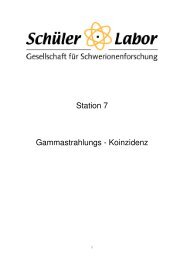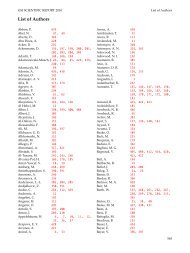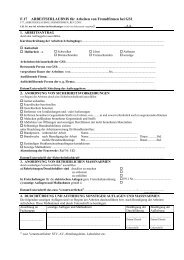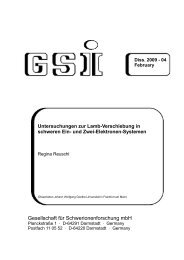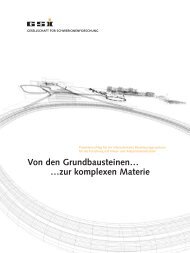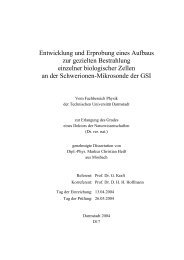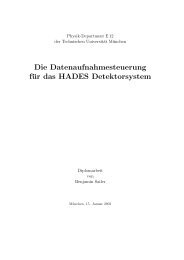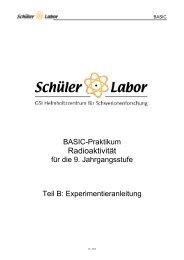CBM Progress Report 2006 - GSI
CBM Progress Report 2006 - GSI
CBM Progress Report 2006 - GSI
Create successful ePaper yourself
Turn your PDF publications into a flip-book with our unique Google optimized e-Paper software.
<strong>CBM</strong> <strong>Progress</strong> <strong>Report</strong> <strong>2006</strong> Detector Developments<br />
<strong>Progress</strong> in the <strong>CBM</strong>-TOF wall, R&D and simulation ∗<br />
D. González-Díaz 1 , E. Cordier 2 , and A. Semak 3<br />
1 <strong>GSI</strong>, Darmstadt, Germany; 2 Physikalisches Institut, Universität Heidelberg, Germany; 3 IHEP, Protvino, Russia<br />
The <strong>CBM</strong>-TOF group aims at providing high π/k separation<br />
(more than 2-σ in the reconstructed mass) in Au+Au<br />
central collisions at 25 GeV/A, with a coverage of midrapidity<br />
by at least 1 unit in y and 1 GeV in p T . These PId<br />
capabilities are needed for probing the QGP phase, through<br />
the study of such fundamental observables as the dynamical<br />
fluctuations of the kaon yield, kaon flow, hyperon production<br />
close to threshold and open charm.<br />
Based on simulation, it was shown that the mentioned<br />
requirements can be satisfied by a tRPC (timing Resistive<br />
Plate Chamber) wall placed at 10 m distance from the target<br />
with 25-30 ◦ coverage in θ (∼150 m 2 ), featuring a time<br />
resolution of 80 ps and an occupancy per cell below 5% (∼<br />
60.000 cells). In order to cope with the high beam luminosity,<br />
the tRPC must handle rates up to 20 kHz/cm 2 , while the<br />
FEE must process the very fast GHz signals from the tRPC<br />
at an interaction rate up to 10 MHz.<br />
The <strong>CBM</strong> spectrometer benefits from the excellent overall<br />
PId capabilities of the TOF wall: for example, the π/e<br />
separation in time of flight is 3-σ for p=1.1 GeV, that provides<br />
extra π suppression (apart from that of RICH and<br />
TRD detectors) in view of di-electron spectroscopy.<br />
Current R&D activities [1, 2, 3, 4, 5] focus on the development<br />
of high rate capability tRPCs, aiming at extending<br />
their working principle from few hundreds of Hz/cm 2 up to<br />
the required rate of 20 kHz/cm 2 , for <strong>CBM</strong> usage. But also<br />
improvements on the description of the timing properties of<br />
the detector at high rates have been recently accomplished<br />
[6]. As a consequence of the latter, the idea that the deterioration<br />
of tRPC performances at high rates is mainly driven<br />
by the DC column resistivity ρd (resistivity times the resistive<br />
plate thickness per gap) is now more sound.<br />
σ T [ps]<br />
ε<br />
150<br />
130<br />
110<br />
90<br />
70<br />
50<br />
1<br />
0.95<br />
0.9<br />
0.85<br />
0.8<br />
0.75<br />
0.7<br />
10 −1 0.65<br />
10 0<br />
float glass (ionizing particles [1]<br />
from C collisions)<br />
semiconductive glass (10−40 MeV e−) [2]<br />
float glass (10−40 MeV e−) [3]<br />
AL940CD cheramics (0.511 MeV γ) [4]<br />
Φ [kHz/cm 2 ]<br />
Φ = 20 kHz/cm 2<br />
10 1<br />
σ T = 80 ps<br />
ε = 0.95<br />
Figure 1: Compilation of different measurements.<br />
A number of measurements was performed at different<br />
rates under different conditions: with ionizing particles<br />
from carbon collisions at <strong>GSI</strong>-SIS [1], with 10-40 MeV<br />
∗ Supported by JRA12 of EU/FP6 Hadronphysics (see annex), INTAS<br />
Ref. Nr. 03-54-3891 and German BMBF contract 06 HD190I.<br />
10 2<br />
39<br />
electrons at the ELBE LINAC [2, 3] and with γ sources<br />
[4]. Among the more promising candidates for the resistive<br />
plates of high rate tRPCs, semi-conductive glasses [2]<br />
and ceramics [4] must be mentioned, whereas the possibility<br />
of using warm thin glass deserves also consideration<br />
[5]. A compilation of results is shown in Figure 1, together<br />
with the dependence on rate Φ obtained in [6]:<br />
εo<br />
ε <br />
1 + Ae−B/Φ , σT σo(1 + CΦ) (1)<br />
where εo, σo, A, B, C are obtained from the fit to data.<br />
The current theoretical and experimental understanding<br />
of the detector has been used to better model the detector<br />
geometry and its response. Starting from the simulation of<br />
the gap response, a realistic description of the position resolution,<br />
inclined tracks and multiple hits have been provided<br />
for the first time. The studies performed after full tracking<br />
through <strong>CBM</strong> confirm the statements of paragraph 2 (see<br />
D. Kresan et al., this report) and open the path to a detailed<br />
comparison between pad and strip technologies that are<br />
currently existing for the tRPC readout. A first approach to<br />
the final mechanical structure has also been accomplished,<br />
where the distribution of the wall in towers looks by now<br />
the more suited solution, providing a high flexibility and a<br />
comfortable distribution of the weight (Figure 2).<br />
Figure 2: Front view of the TOF wall, divided into towers.<br />
Details on the FEE, mostly focused on ASIC design, can<br />
be found in M. Ciobanu et al., in this report.<br />
References<br />
[1] H. Alvarez-Pol et al., NIM A, 535(2004)277.<br />
[2] F. Dohrmann, talk at VIII <strong>CBM</strong> coll. meeting.<br />
[3] R. Kotte et al. NIM A, 564(<strong>2006</strong>)155.<br />
[4] L. Lopes et al., Nucl. Phys. B, (Proc. Suppl), 158(<strong>2006</strong>)66.<br />
[5] P. Fonte et al., PoS(HEP2005)376.<br />
[6] D. Gonzalez-Diaz et al., Nucl. Phys. B, (Proc. Suppl),<br />
158(<strong>2006</strong>)111.



